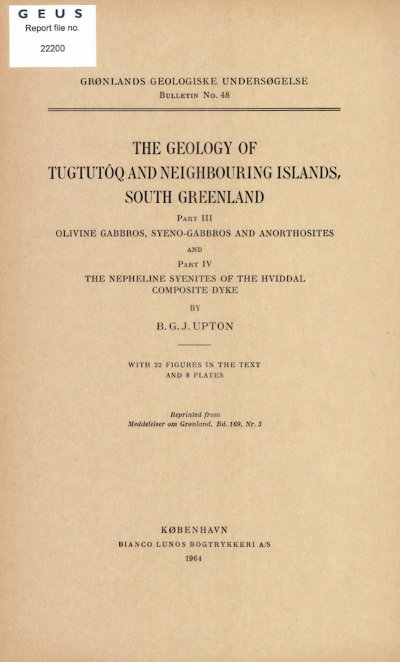The geology of Tugtutôq and neighbouring islands, South Greenland. Part III. Olivine gabbros, syeno-gabbros and anorthosites. Part IV. The nepheline syenites of the Hviddal composite dyke
DOI:
https://doi.org/10.34194/bullggu.v48.6582Abstract
Large Precambrian (Gardar) ENE-WSW dykes traverse the Tugtutôq region and can be traced for some 50 km. Thicknesses of up to 800 m in the ENE diminish rapidly towards the WSW. The earliest of the large dykes is composite with intrusion of syeno-gabbro followed by median intrusion of nepheline syenite. The syenogabbro has feldspar zoned from ca. An67 to Or21∙5Ab65An13∙5 with olivines ranging from Fa54-64, augitic pyroxene, biotite, ore and apatite. Subsequent intrusion of high aluminous alkali basalt magma produced massive dykes of troetolitic gabbro in the granitic basement complex, a large sill-like body along the unconformity separating the granitic rocks from the Gardar series of sediments and volcanics, and smaller sills within the Gardar series. The gabbro dykes have synformal internal structures defined by mineral banding and feldspar lamination developed at irregular intervals along their length as does also the large overlying sill. The gabbro intrusion as a whole is regarded as a layered body displaying limited cryptic and phase layering. The gabbroic rocks are orthocumulate sequences formed by bottom accumulation of crystals in a period of tectonic instability.
As a result of tilting towards the ENE, lower level rocks are exposed towards the WSW of the intrusion where the cumulus phases were feldspar ca. An 72 and olivine Fa35-40. Interstitial pyroxene is a titanaugite, Ca45∙5Mg37∙5Fe17. In the higher rocks towards the ENE the cumulus feldspar (An65) and olivine are joined by cumulus ilmenomagnetite and fluorapatite. In one sector a gabbro dyke is composite with median intrusion of syeno-gabbro followed by quartz syenite.
This syeno-gabbro has feldspar zoned from Or4Ab62An34 to Or8Ab73An19, with early clinopyroxene (Ca44∙5Mg36Fe19∙5 → Ca44∙5Mg32∙5Fe23), olivine, (Fa72), biotite, ore and fluorapatite.
Four rock analyses and three pyroxene analyses are presented for the gabbros and syeno-gabbros. Inclusions of labradoritite and gabbroic anorthosite, considered to be samples from a large anorthositic body at depth, are brought up by the large dykes and also by a later swarm of hybridised dolerite dykes. The inclusions range from layered labradorite-orthocumulates ((with An57) and interstitial olivine (Fa33) and augite) to cataclastic varieties with no fresh ferromagnesian minerals. A late Gardar swarm of ENE dykes and associated sills of camptonitic dolerite is believed to be genetically related to the earlier syeno-gabbros and gabbros.
Downloads
Published
Issue
Section
License
This article is distributed under a CC-BY 4.0 licence, permitting free redistribution and reproduction for any purpose, even commercial, provided proper citation of the original work. Author(s) retain copyright over the article contents.


